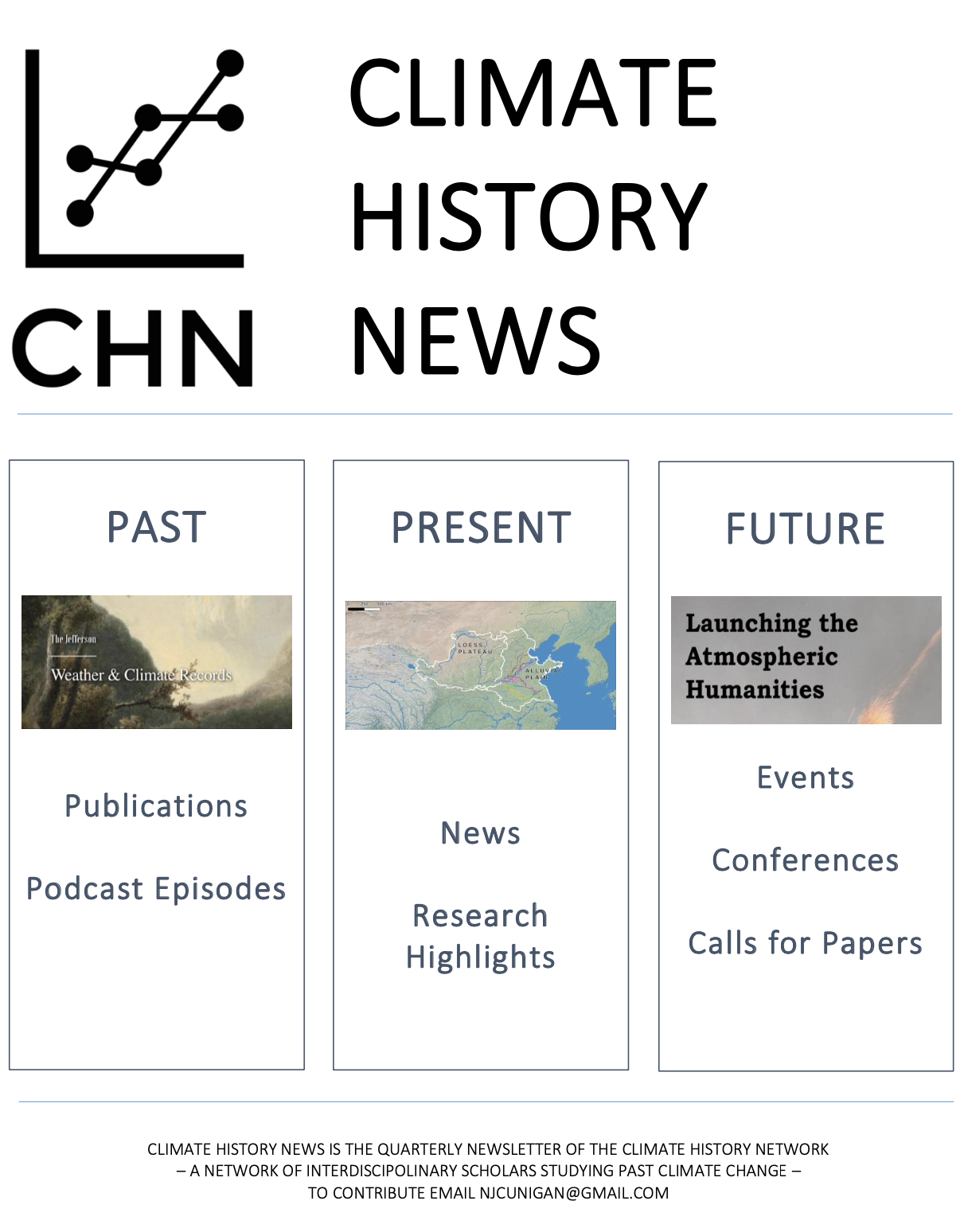A new article published in the Scandinavian Journal of History reviews the use of climate as a historical lens in Nordic countries. Reviewing major works published in languages other than English and identifying prominent trends in the climate history of Denmark, Sweden, Norway, Finland, and Iceland, as well as Estonia, the article concludes by offering ten suggestions for advancing the conversation around climate and history further. Read the full article here.
Volume 7, Issue 1 of the CHN Newsletter Published
Nicholas Cunigan, our newsletter editor, has published the latest issue of our Climate History Newsletter. This newsletter is once again packed full of content, including links to new podcast episodes and feature articles at HistoricalClimatology.com, and a nearly 10-page bibliography of the year’s publications in climate history, historical climatology, and paleoclimatology.
Download the issue by clicking here.
Historic narratives, myths and human behavior in times of climate change: A review from northern Europe's coastlands
A recent article published in WIREs Climate Change analyzes how historically rooted community identity in Frisia has impacted decisions about adapting to climate change. Drawing on archaeology, literature, and historical sources, authors Jessica Holzhausen and Kevin Greksch argue that ideas about land reclamation are embedded in the collective identity of this north German region and that this identity has helped shape policies today. Taken more broadly, their work suggests that other communities’ histories and ideas about themselves need to be taken into account in crafting effective policy solutions to future climate change. Read the full article here.
Last Glacial Maximum extent of the Patagonian Ice Sheet, Chiloé (Chile)
A new study of glacial moraines in southern Chile offers a better understanding of glaciation in the region during the period prior to the Last Glacial Maximum. By analyzing beryllium isotopes in glacial till, the researchers found that the period of Marine Isotope Stage 3, often described globally as an interstadial and well-mapped only in polar regions, experienced significant climate variability. This climatic variability was born out by relatively rapid responses at the century and millennial scale by the Patagonian Ice Sheet. Read the full study here.
Climate variability and grain production in Scania (Sweden), c. 1702-1911
New research on grain production in Scania, southern Sweden between 1702 and 1911 suggests that output was unequally sensitive to climate trends throughout the year, correlating higher outputs with cooler summers and drier winters. Conversely, yields were relatively insensitive to variation during spring and fall. These trends became less strong for the latter years of the series as new cultivars were introduced in the region. Read the preprint article here.
Towards a More Rigorous Understanding of the Societal Impacts of Climate Change
A new article in the journal Nature coins a new term – the “History of Climate and Society” (HCS) – to refer to the truly interdisciplinary study of the past impacts of climate change on human populations. It offers a detailed critique of the field as it has been pursued to date, presents a new research framework for HCS scholars, and shows how the application of that framework can permit new scholarship into the resilience and adaptability of populations that faced the modest, pre-industrial climate changes of the past 2,000 years. The article identifies five “pathways” that allowed populations to endure and even exploit these changes, and suggests that those pathways can help us prepare for the future.
At HistoricalClimatology.com, Dagomar Degroot, lead author of the article, describes how and why he developed the project. A new episode of our podcast, Climate History, features a conversation between co-authors Degroot and Emma Moesswilde that explores the significance of the article for understandings of both the past and the future.
Online Exhibition: Weather Histories
The online exhibition “Weathered History” is now available at:
https://artsandculture.google.com/exhibit/weathered-history/hwJiMeBlg6zDLg
Description:
Contemporary and historical climate change in itself takes place beyond the scale of human perception. Yet scholars can combine instrumental data, proxy information, and written sources to reconstruct these patterns. What humans could see in the past and can still perceive today are meteorological extremes: droughts, heat waves, floods, cold spells, and storms. Such extreme events, however, have generally left only indirect evidence in the material heritage of past human societies. The exhibition ‘Weathered History’ on Google Arts & Culture, a product of PAGES’s working group CRIAS supported by the Leibniz Institute for the History and Culture of Eastern Europe (GWZO), presents this legacy to a wider public. At times surprising objects are witnesses of human memory to meteorological disasters, but they also show how skillfully historical societies adapted to past climate change.






